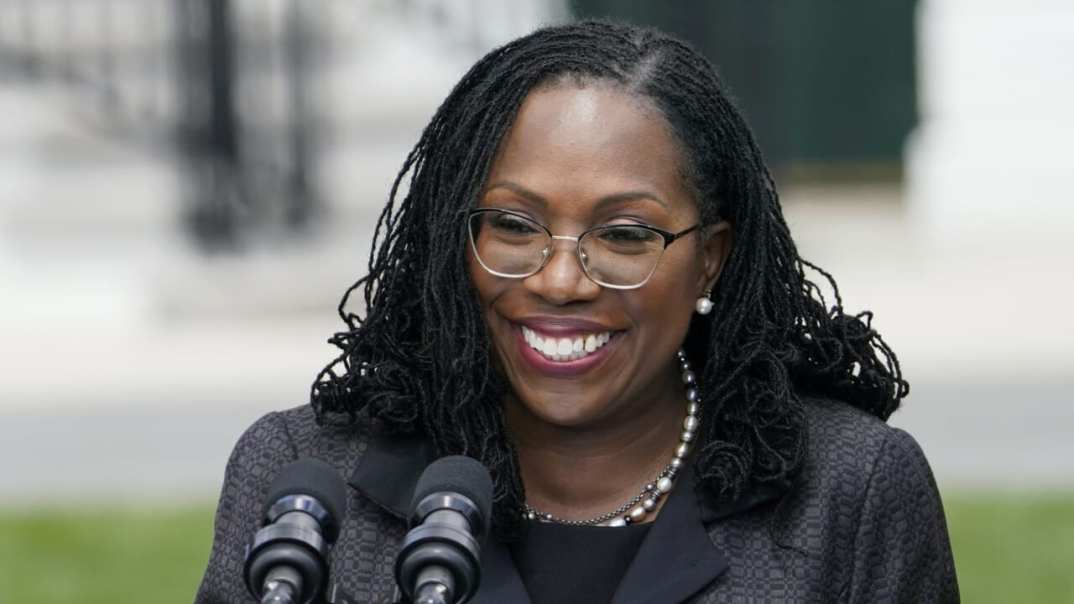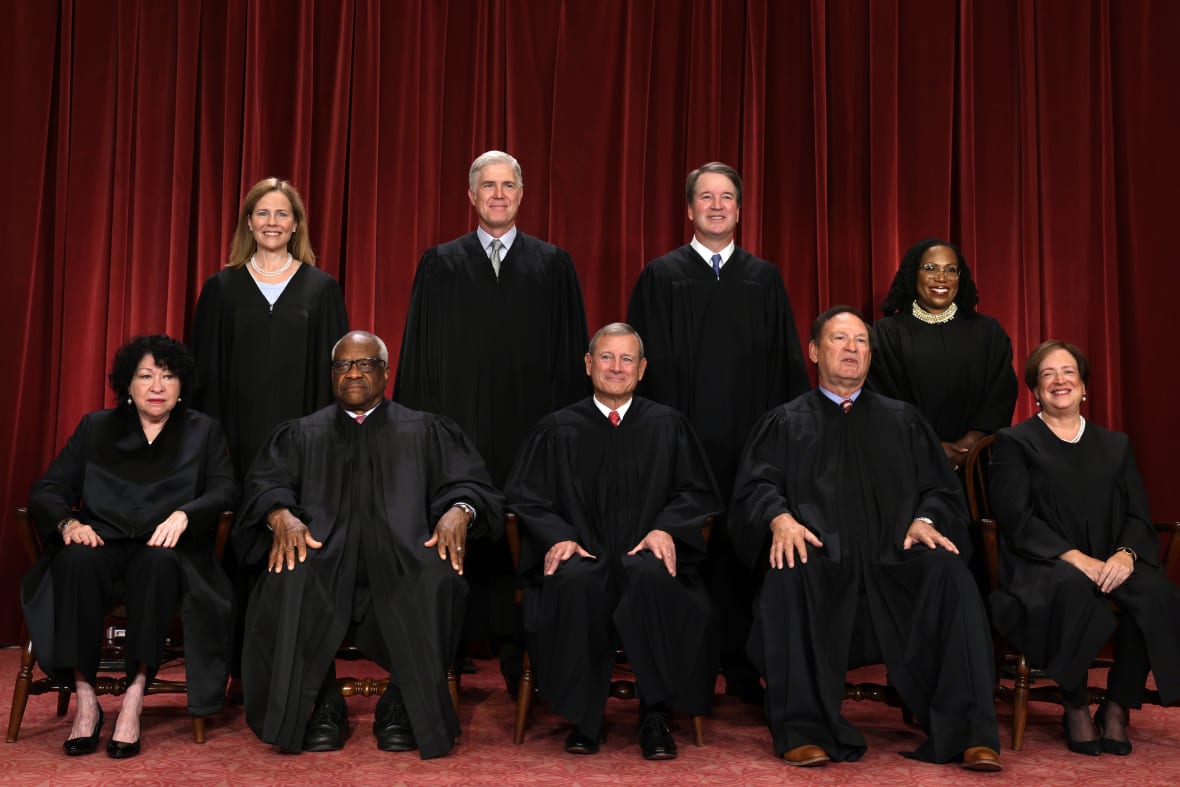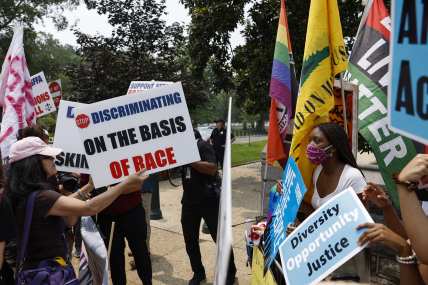The breakdown of Justice Ketanji Brown Jackson’s dissent — because y’all didn’t hear her
OPINION: In her factual, pointed dissent, Justice Jackson explains why the Supreme Court affirmative action decision was “a tragedy for us all.”

Editor’s note: The following article is an op-ed, and the views expressed are the author’s own. Read more opinions on theGrio.
For the justices in the back. This one’s for you.
Actually, no. It’s for all the Black girl lawyers like myself, who see in Justice Ketanji Brown Jackson something amazingly powerful that we’ve never seen before.
Something made possible by Black excellence and the very affirmative action precedent that was overturned in last Thursday’s Supreme Court decision.
In her well-written dissent, Justice Jackson plainly laid out for the justices (and all who were unclear) that the majority’s opinion actually worked against the goals of the 14th Amendment and not in support of it. In her words, it was “without any basis in law, history, logic, or justice.” (That’s professional code for … it didn’t make sense.)
The 14th Amendment, which reads in part, “[n]o State shall…deny to any person…the equal protection of the laws,” has been interpreted, as Justice Jackson points out, to support affirmative action in several prior Supreme Court cases.
As the liberal justices agreed in Justice Sonia Sotomayor’s dissent, this equal protection clause creates a guarantee of racial equality — (not a guarantee of facially race-neutral, colorblind policies) — but a guarantee of actual racial equality. Decades of Supreme Court opinions support the notion that to accomplish this racial equality, race-conscious means are appropriate when they are narrowly tailored to serve a compelling interest, such as colleges obtaining the educational benefits of racial diversity on their campuses.
As Justice Jackson explained in a footnote, the goal of her dissent was to focus on highlighting exactly what was at stake by the court’s decision and expound upon why factoring in race as a part of a holistic college admissions process is needed and constitutional.
Justice Jackson took us on a history lesson and then swerved back to the present day with stats to back up her argument that the benefit of racial diversity on college campuses is actually needed to accomplish the guarantees of the equal protection clause. She scoffs at the majority’s “ostrich-like” perspective — I call it something else — that colorblind policies help promote racial equality. And through what’s probably her most tweeted line, she calls out the inner Marie Antoinette in the Republican-appointed justices, accurately naming their “let-them-eat-cake” attitude, as just that.
But like all good arguments, she starts with a history lesson.
Justice Jackson’s history lesson
She sets the stage for this lesson by highlighting America’s origins and its original unequal protection of law: Black people’s forced servitude during slavery. Essentially, Black Americans started in the trenches, while White Americans were given the freedom to run, unencumbered by race, toward their goals–with the full support of our government.
From here, she walks down the horrid halls of history pointing out almost every government-sanctioned unequal protection of the law throughout history that the majority seemed to gloss over.
She touches on how slavery transitioned into forced sharecropping. Then, how unfair sharecropping debt, coupled with vagrancy laws that jailed Black men, rolled over into Jim Crow. That in turn, she explained, ushered in the Great Migration north, which brought about racially exclusionary zoning and laws and policies that locked many Blacks out of homeownership–a key wealth builder for Americans.
The point behind her history lesson is to draw attention to the fact that Black people are not statistically behind White people in key markers of health, wealth, and well-being by mere accident. It’s a direct reflection of a history of government-sanctioned discrimination against Black people that never allowed Blacks to catch up.

These laws and discriminatory policies throughout history, by their very nature, offered government-sanctioned advantages for White people. (People seem to miss that point.) White Americans’ progress is statistically better than most races as a direct result of past actions by the government favoring them and disfavoring other races. The two cannot be separated.
The effects of this affirmative support given to Whites still exist today–in “[g]ulf-sized race-based gaps.”
These “gulf-sized race-based gaps”
Justice Jackson opened her dissent by talking about these gaps, as they are the greatest support for her argument on why affirmative action is still needed to actually provide equal protection of the law.
She noted that these gaps “were created in the distant past, but have indisputably been passed down to the present day through the generations.” She emphasizes how as recently as 2019, white families’ median wealth was approximately eight times that of Black families,’ and that, just like 50 years ago, Black homeownership trails white homeownership by approximately 25%.
She shares that Blacks in their late 20s are about half as likely as whites to have college degrees, often borrowing more due to lower family income, and ultimately, graduating college with nearly twice the debt of whites.
She points out that Black people make up only about 5% of lawyers despite being 13% of the population, and that as of 2022, only six of the CEOs on the Fortune 500 list were Black.
It’s these statistics that emphasize that “[a]lthough formal race-linked legal barriers are gone, race still matters.” This underscores the need for continued affirmative action to counteract government policies from the past that, as she put it, “one could say, affirmatively acted” to benefit non-Blacks.
This “Let-them-eat-cake” attitude
Justice Jackson did not hold her tongue when it came to telling the conservative justices exactly what they sounded like— an oblivious queen out of touch with the needs of real people. This was the line in her dissent that struck a chord with many.
She writes: “With let-them-eat-cake obliviousness, today, the majority pulls the ripcord and announces ‘colorblindness for all’ by legal fiat. But deeming race irrelevant in law does not make it so in life.”
As her dissent notes, it is actually holistic admissions practices that consider race that are pushing us toward an idealistic society where one day the aforementioned gaps may no longer exist along racial lines. But we aren’t there yet. So, to arbitrarily pull the rug from under the feet of progress based on nothing more than a partisan belief that Republicans think time’s up is not only counter to the Constitution’s mandate…it’s actually just a made-up notion masquerading as a legal doctrine.
Sidebar: As an attorney who practiced in courtrooms for 10 years, please believe me when I tell you that in the courtroom, it can matter much more who your judge is than what the law says. That’s how made-up notions become legal doctrine.
The compelling interest in promoting racial diversity at colleges
That sentiment I just discussed about judges seeing what they want to see in the law plays out here. The majority smoothly sidestepped decades of Supreme Court cases in favor of its own predictable, partisan interpretation. Although prior Supreme Court cases focused on determining whether there was a compelling interest for race-conscious admissions tests, as legal precedent directed them to, it’s actually Justice Jackson’s dissent that dives into these reasons that the majority ignores.
She talks about schools’ interest in students benefiting from diversity through the prevention of racial isolation on campus. She cites research to support that living and working with at least some other people who look like them matters to a student’s ability to learn and succeed in college.
Additionally, she asserts that through diversity, students who don’t actually share the same stories will interact and come to understand each other’s stories, which “improves cognitive abilities and critical-thinking skills, reduces prejudice, and better prepares students for postgraduate life.”
She speaks about the importance of universities producing highly educated professionals of color. “Research shows that Black physicians are more likely to accurately assess Black patients’ pain tolerance and treat them accordingly,” she says. “For high-risk Black newborns, having a Black physician more than doubles the likelihood that the baby will live, and not die.”

There’s no such thing as ‘race neutral’
And while some of these benefits directly affect Black people, she notes the impact on the nation. “[E]nsuring a diverse student body in higher education helps everyone, not just those who, due to their race, have directly inherited distinct disadvantages with respect to their health, wealth, and well-being.”
She remarks that “students of every race will come to have a greater appreciation and understanding of civic virtue, democratic values, and our country’s commitment to equality. The larger economy benefits, too: When it comes down to the brass tacks of dollars and cents, ensuring diversity will, if permitted to work, help save hundreds of billions of dollars annually.”
Unfortunately, all of these benefits to diversity, that legally should have been considered, were ignored by the majority.
To be quite blunt, these Republican-appointed justices did what they wanted to do. End of story. Despite the support laid out in Justice Jackson’s dissent and the dissent of Justice Sotomayor that she joined, the majority threw a few weak citations at us and then just did what they wanted to do anyway.
One of the major weaknesses in their argument is their ruling — within the same case — that consideration of race was OK at military academies. As Justice Jackson puts it, there’s only one conclusion from this, and it’s that “racial diversity in higher education is only worth potentially preserving insofar as it might be needed to prepare Black Americans and other underrepresented minorities for success in the bunker, not the boardroom.”
The fact that this same decision allowed race-based considerations to remain for military academies but not other higher education institutions further supports the liberal justices’ statements that there’s nothing in the Constitution that prevents race-conscious admissions practices — it’s just about when Republicans want to use them and when they don’t. And that is truly the “tragedy” Justice Jackson spoke of.

Kamaria is an attorney, poet, writer, and lover of all things created #ForTheCulture. She runs a blog, ‘Words of My Mother,’ has lived all over the DMV (heavy on the V), and enjoys skating, debating, and car karaoke. (Because, why not?!) She can be reached on Twitter at @like_tha_moon.
TheGrio is FREE on your TV via Apple TV, Amazon Fire, Roku, and Android TV. Please download theGrio mobile apps today!

